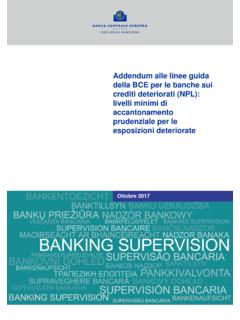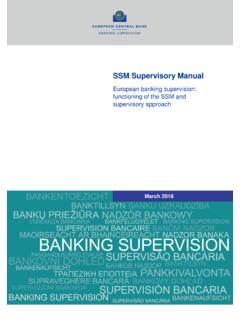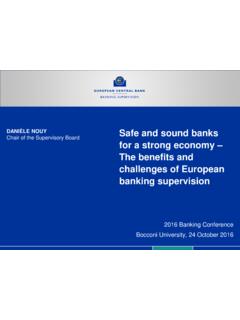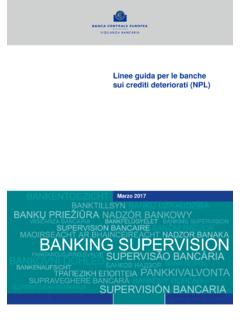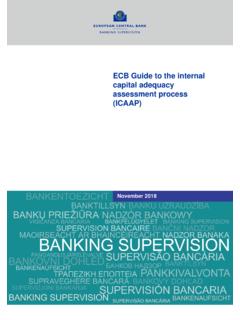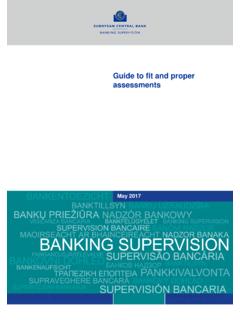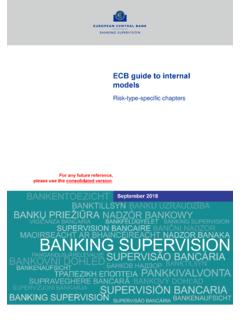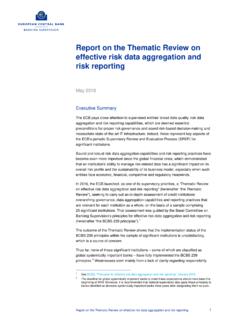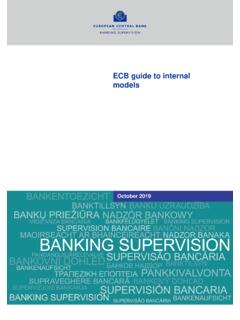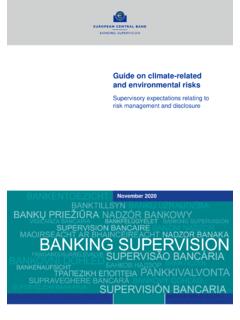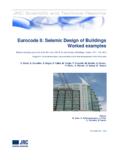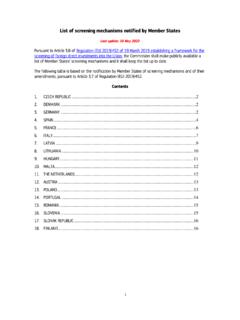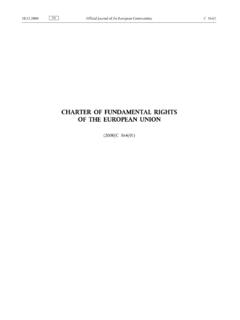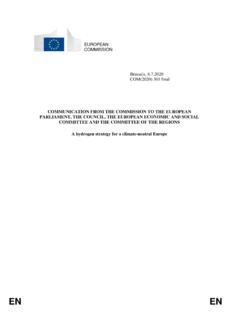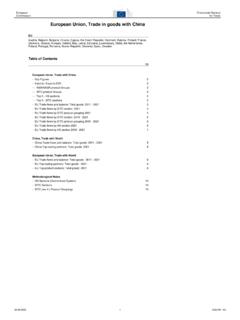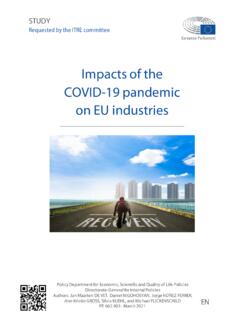Transcription of Guide to fit and proper assessments
1 Guide to fit and proper assessments December 2021 Guide to fit and proper assessments Contents 1 Contents Foreword 4 Guiding principles 5 1 Scope of the ECB s fit and proper assessments 6 2 Legal framework 7 SSM Regulation and SSM Framework Regulation 7 CRD and national law 7 ESMA/EBA Guidelines 8 SSM policy stances, supervisory practices and processes 8 3 Assessment criteria 9 Experience 9 Practical experience and theoretical knowledge 9 Information 10 Assessment approach 10 Special cases 13 Reputation 14 Information 15 Assessment approach 18 Conflicts of interest and independence of mind 22 Information 24 Assessment approach 25 Conflicts of interest statement 28 Time commitment 30 Concept of time commitment 30 Information 30 Assessment approach 32 Collective suitability of the management body 40 Guide to fit and proper assessments Contents 2 Information 43 Assessment approach 44 Assessment of individual
2 Accountability of board members 45 Scope 45 Findings 46 FAP criteria and detailed assessment 48 Process 49 Collection of information and fit and proper interview 50 Outcome of the assessment 50 4 Fit and proper -related authorisations 51 Additional non-executive directorship 51 Information 51 Combining the functions of Chair and CEO 52 Assessment approach 53 Process to apply for authorisation to hold an additional non-executive directorship or to combine Chair and CEO functions 53 Application by the credit institution or by the appointee? 54 When does the application have to be submitted? 54 Coordination with FAP applications submitted at the same time 54 5 Situations that lead to a fit and proper assessment other than new initial appointments 55 Changes of role, renewals and departures from office 55 General rule 55 Changes of role 55 Renewals 56 Departures from office 56 Reassessments 56 Assessment approach 57 Guide to fit and proper assessments Contents 3 Step 1 reassessment (prudential assessment of new facts, their materiality and severity of their impact) 58 Step 2 reassessment (adoption of a final ECB decision)
3 60 General guidance on whether or not a new fact may lead to a reassessment 61 6 Interviews 65 Purpose 65 ECB approach to interviews 65 Timing 67 Procedural aspects 68 Notification 68 Interview 68 7 Notifications, decisions and ancillary provisions 70 Notification of intended appointments 70 Types of decision 71 Time frame 71 Hearings 72 ECB decision and notification 72 Positive decision with a condition 73 Supervisory practice 73 Positive decision with an obligation 75 Positive decision with recommendations or expectations 75 Other types of power 76 Reassessments and removals 76 8 Useful links 77 Guide to fit and proper assessments Foreword 4 Foreword The management body of a credit institution2F3 must be suitable in order to carry out its responsibilities and be composed in such a way that contributes to the
4 Effective management of the credit institution and balanced decision-making. This will have an impact not only on the safety and soundness of the credit institution itself, but also on the wider banking sector, as it will reinforce the trust of the public at large in those who manage the financial sector of the euro area. Since 4 November 2014, the ECB has been responsible for taking decisions on the appointment of all members of the management bodies of the significant credit institutions that fall under its direct supervision. The objective of this revised version of the Guide to fit and proper assessments which replaces the previous version, last updated in May 2018, is to explain in greater detail the policy stances, supervisory practices and processes applied by the ECB when assessing the suitability of members of the management bodies of significant credit institutions and to specify the ECB s main expectations.
5 The policy stances, supervisory practices and processes described in this Guide may have to be adapted over time. It is meant to be a practical tool that will be updated regularly to reflect new international and European legal and regulatory developments and experience gained over time in fit and proper supervision. This Guide is not, however, a legally binding document and cannot in any way substitute the relevant legal requirements stemming either from applicable EU law or applicable national law, nor does it introduce new rules or requirements. To the extent possible, the Guide follows the terminology used in the Capital Requirements Directive (CRD),3F4 the joint ESMA and EBA Guidelines on suitability4F5 and the EBA Guidelines on internal For example, the term management body applies to the bodies in all governance structures that perform management or supervisory functions.
6 The Guide does not advocate any particular governance structure and is intended to embrace all existing structures. 1 All institutions under the direct supervision of the ECB (significant institutions), whether credit institutions or (mixed) financial holding companies. 2 The person who is proposed for a position in the management body or who has been appointed to such position. 3 As defined in Article 4(1), point (1) of Regulation (EU) No 575/2013 of the European Parliament and of the Council of 26 June 2013 on prudential requirements for credit institutions and amending Regulation (EU) No 648/2012 (OJ L 176, ), (Capital Requirements Regulation CRR).
7 4 Directive 2013/36/EU of the European Parliament and of the Council of 26 June 2013 on access to the activity of credit institutions and the prudential supervision of credit institutions, amending Directive 2002/87/EC and repealing Directives 2006/48/EC and 2006/49/EC (OJ L 176, , p. 338). 5 Joint ESMA and EBA Guidelines on the assessment of the suitability of members of the management body and key function holders under Directive 2013/36/EU and Directive 2014/65/EU (EBA/GL/2017/12). 6 EBA Guidelines on internal governance under Directive 2013/36/EU (EBA/GL/2017/11). In this document, the terms credit institution and supervised entity 0F1 are used interchangeably, as are the terms member and appointee.
8 1F2 The term competent authority includes both NCAs and the ECB. Different terms are defined in the text and in the footnotes. In addition, please consult the central ECB glossary. Guide to fit and proper assessments Guiding principles 5 Guiding principles The credit institutions are primarily responsible for the initial and ongoing assessment of the suitability of the members of the management body and key function holders. The supervisor expects that the appointee will disclose all relevant proceedings to the best of their knowledge and will be transparent and honest with the ECB and the national competent authority (NCA). Any document requested by the supervisor must be presented to the extent possible.
9 Otherwise, the reason why it was not possible to obtain and present such information or document should be clearly explained. This Guide , which describes the policy stances, supervisory practices and processes applied by the competent authorities within the Single Supervisory Mechanism (SSM), is designed as a practical tool which will be updated and developed over time. The policy stances contained in the Guide are without prejudice to national law. However, where possible, the ECB and the NCAs strive to interpret national rules consistently with these policy stances. Fit and proper assessments are carried out on a case-by-case basis and this Guide should serve as a practical tool only.
10 Therefore, in each case, the assessment will come down to an analysis of the individual situation and supervisory judgement. The supervisory practices described in the Guide respect the principle of proportionality, namely that they are commensurate with the size, systemic importance and risk profile of the credit institutions under supervision and the efficient allocation of finite supervisory resources. The suitability assessment conducted by the competent authorities is prudential and preventive in nature and highly dependent on the available information. It is distinct from criminal or administrative infringement procedures. The fit and proper assessment feeds into the ongoing supervision of the governance of a credit institution.
